Ask a Wellesley woman what she thinks, and it’s fairly certain she won’t hold back. That proved true earlier this year when the Alumnae Association sent an email survey to 28,000 alumnae in hopes of learning how they are engaging with the College and each other, where that engagement seems most effective, and whether there were opportunities for making new alumnae connections through new programs.

Click here to enlarge this graph and see more findings from the survey.
Ask a Wellesley woman what she thinks, and it’s fairly certain she won’t hold back.
That proved true earlier this year when the Alumnae Association sent an email survey to 28,000 alumnae in hopes of learning how they are engaging with the College and each other, where that engagement seems most effective, and whether there were opportunities for making new alumnae connections through new programs.
More than 4,500 alumnae responded to the survey, answering questions on everything from their overall satisfaction with their undergraduate experience to the types of communications they prefer from the College. They weighed in on the value of alumnae friendships and how active they were with Wellesley classes, clubs, and shared interest groups. The response rate was 16 percent—far greater than the usual 5 to 7 percent for email surveys—creating a very small margin of error (plus or minus 1.3 percent).
‘I loved that as self-identified groups, young alumnae and alumnae of color appear to be the most willing to recommend Wellesley to a prospective student and to volunteer to mentor.’
WCAA president Georgia Murphy Johnson ’75 says the most important takeaway for her is that “most alumnae are very satisfied with their college experience and that translates into their being very engaged alumnae.”
Missy Siner Shea ’89, the executive director of the Alumnae Association, sees opportunities for WCAA activities as a result. “I see an opening to improve the WCAA’s communications,” she says. “My staff and I are excited to use these survey results to shape our direction and programming.” She points to an alumnae-student mentorship program now under development in partnership with the Career Education office as an example of one of the first outcomes of the survey.
Click on the graph above to see the most important survey findings.